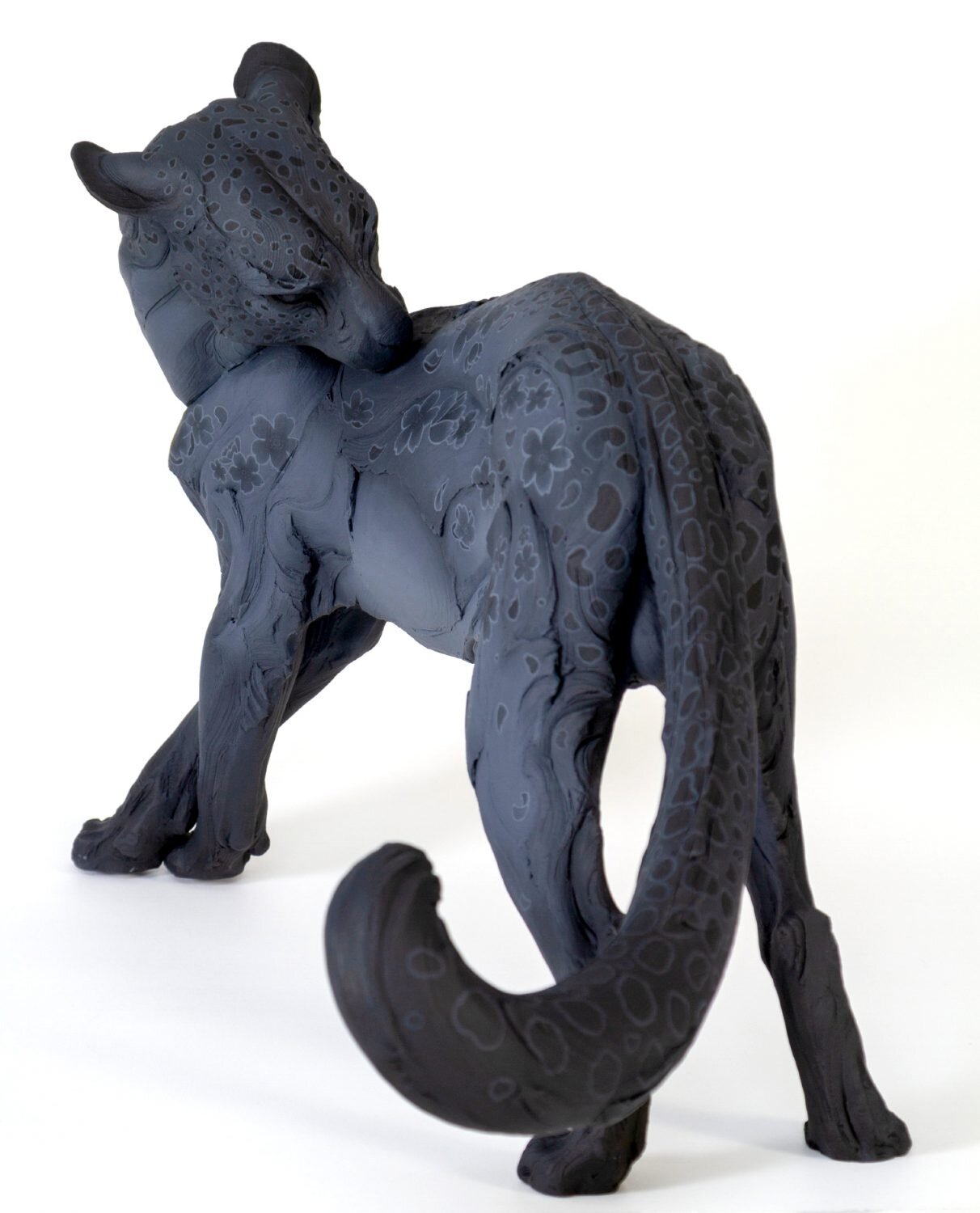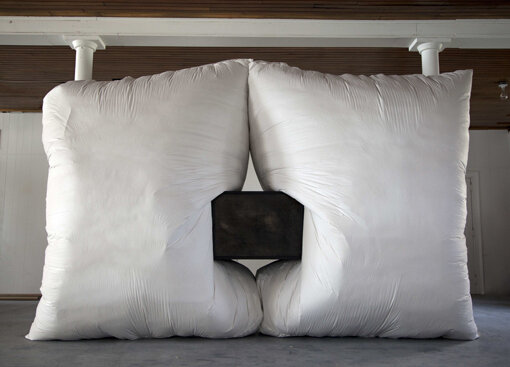NCECA Highlight: Elliott Kayser
We couldn’t be more excited that NCECA is coming to Richmond, VA this year. If you’re unfamiliar, it’s the National Council on Education for the Ceramic Arts. There will be 4 days of conferences and many many shows sprinkled throughout the city. We’re thrilled to be hosting artist Elliott Kayser at Focal Point Space. Before you visit to see his latest works, we wanted to give you a glimpse at his background and current practice. We can’t wait to host him and share his work with all of you!
Photo by Christian Garcia
HAND / THROWN: When were you first introduced to ceramics and how early did you know it was a medium that you wanted to stick with?
ELLIOTT KAYSER: I took my first ceramics class at Multnomah Art Center in Portland, OR when I was 10 years old. My mother at the time had been enrolled in a community college ceramics class; she brought home a cookie jar shaped like an armadillo that she made. I was so excited about that cookie jar that I asked if I could do ceramics too. She signed me up and I never stopped.
H/T: When you’re working through an idea or a form, how does it develop?
EK: My creative process generally begins from writing and reflecting on my time working on farms. I read a lot about how agriculture in this country is changing. Wendell Berry is a favorite author of mine. Once I find a quote or question that I can’t stop pondering, I must get my hands on some clay. The material is so tactile and grounded, clay helps me to feel and see what I am thinking about. I often go through several revisions in clay before I land on a sculpture that I feel speaks poetically. It is a challenge to make animal sculptures that are not anthropomorphic, kitschy, or overtly political. I am making work to start a conversation about what our role as stewards of the land should look like.
Photo by Deanna Dent
H/ T: Working with clay on a larger scale can sometimes feel very overwhelming. How did you make the leap to larger forms and what were some of the challenges?
EK: I enjoy how working large is physical. At the end of a day my body is tired, the exertion is rewarding and helps dispel any pent-up anxiety or stress. The larger scale provides plenty of engineering challenges, which depending on the day can be quite fun. On the days I don’t get it right, I am grateful for using molds, so I can try again. The biggest challenge is always time, with many of my works taking up to a month to dry before firing.
H/T: With this exhibit, you’re working with raw clay and facilitating growth from one of your latest pieces. Can you talk a little bit about the importance of materiality and experimentation in your process.
EK: Since my undergrad years I have explored time-based interactive artwork; often utilizing the relationship clay has to permanence and fragility. In my latest experiment I created a raw clay “seed bomb” from raw, unfired clay with the hope of it breaking down and germinating the ground around it with native Virginia wildflowers.
In progress detail of "seed bomb”, photo by Christian Garcia
In general I use molds as part of my process as a way to liberate myself from sculptures becoming too precious. My process before making the molds is very formal, rooted in classical sculpture; everything that comes after is liberated to be experimental. I cut up and reassemble forms and add contaminates into my clay body as ways of abstracting the form and adding unpredictability into the final results.
H/T: You speak about working on farms and wanting to know firsthand what it takes to grow the food that you eat. Was this experience alone what led you to the work you’re producing now or was that experience part of a larger interest?
EK: My initial interest in food came out of my relationship to my dad’s family and the Danish holiday traditions I got to experience growing up. Right before I went off to college, that whole side of my family imploded, ending all ties I had to the traditions that connected me to my Danish heritage; even though I was born and raised in the states. I realized so much of my sense of place was connected to food that I began to look at and question what I ate, the ceremony around food, and the power of food to bring people and families together. My relationship to food has in large part been a search for my identity as an American, looking at the traditions, community, and beliefs surrounding food in this country. I began to work on farms as a means to help me answer some of these questions, and make art to help me understand those experiences.
Origin Vase by Elliott Kayser
H/T: Working with clay and farming take a certain level of patience and nurturing, what other similarities do you find between the two and how do they inform your studio process?
EK: I think patience is the big one! Both clay and farming require you to hurry up and wait; be attentive one moment and then be patient and wait, yielding to the passage of time and seasons. Also, working large in clay and farming both require one to give up control, unable to complete the given task in isolation. It requires the reliance on others, the ability to work together and compromise. And last but not least, both potters and farmers show affection by sharing in a good meal. Both communities spend much of their day thinking about food.
H/T: What do you think of the current state of the cattle industry in America? Many people are choosing to stay away from red meat as a way to lessen environmental impact, do you see this as the right action to bring the desired outcome?
EK: I think this is a complicated question, and one that doesn’t have a universally correct answer. I do think that the attempt to live a conscientious life, aware that their actions and decisions affect other people, is an effort worth making. I don’t think farmers and ranchers are villains. For myself, I like Michael Pollan’s advice: Eat food, mostly plants, not too much.
Unclean For You by Elliott Kayser
H/T: You’ve worked with functional, sculptural and performative pieces. How do you see these methods of making as being similar and being different? Do you see repeated patterns in your approaches to different styles of works?
EK: I am still trying to figure this one out for myself, but I believe the different types and modes of work inspire different interactions. Performance/interactive work is a spectacle, meant to be experienced by a crowd. This work rarely has an artifact or physical object, so the shared memory of the experience is what endures through time. My sculptural work tends to inspire philosophical conversation between myself and individual viewers. This dialog isn’t meant to be a way for me to proselytize a particular set of values, but rather as a bridge to building new relationships. The pottery for me is perhaps the least academic but provides a visceral and genuine connection to food. Handmade pottery is something I live with in my everyday life, and as a result it is part of every experience I have of making and sharing food with my family and friends.
Altered Landscape by Elliott Kayser
Herd by Elliott Kayser
Spiked Amphora by Elliott Kayser
Community Still Life In Clay by Elliott Kayser
H/T: What experience are you hoping to facilitate for the viewer, if any, and what do you hope they take away from your work?
EK: Rather than a specific takeaway, I hope the work leads to a dinner table conversation, an opportunity to think and talk about the topics of food, land, and community.
H/T: Who are some artists you admire, ceramic and otherwise?
EK:
Wendell Berry, essayist and poet
Edward Burtynsky, filmmaker and photographer
Masaiomi Yasunaga
Wolfgang Laib
Takuro Kuwata
Beth Cavener
Felix Gonzales Torres
Ian McManhon
H/T: What’s next?
EK: I’m looking forward to exploring the possibilities of creating more raw-earth sculptures, I want to do more investigations into digging or mining my own clay materials. I am still compelled by research I gathered about spiritual/religious practices, objects, and stories that involve cattle. And I plan to spend more time working on farms, and I’d like to learn how to make bread.
To see more work from Elliott Kayser visit his website and instagram.


















